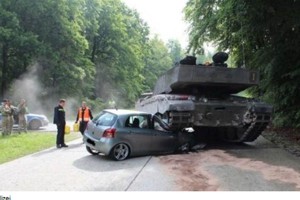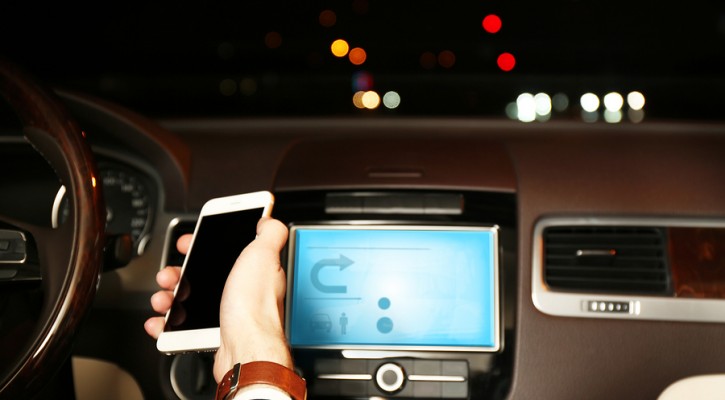Tag Archive: Driving Safety

Ask The Driving School Instructor: Failure To Yield
June 3, 2015
Question: What exactly does failure to yield mean and when does it apply?
Answer: Failure to yield can apply in several different situations but basically, if another driver has to swerve or slam on the brakes to avoid hitting you, you’re guilty of failure to yield. Let’s look at some different situations where failure to yield can come into play.
The 18 year old German girl driving the car in the photo below tried to turn onto a street that is heavily used by military vehicles at a nearby British army base. A military convoy was passing by when she tried to enter the road and, for some mysterious reason, probably involving the laws of physics, the driver of a 68 ton Challenger tank was unable to stop in time. The front half of her car was crushed under the tank. She was guilty of failure to yield.
 http://www.nbcnews.com/news/world/young-drivers-car-crushed-british-tank-augustdorf-germany-n368211
http://www.nbcnews.com/news/world/young-drivers-car-crushed-british-tank-augustdorf-germany-n368211
One mistake people make, especially where large vehicles are concerned, is judging their speed. Large vehicles like buses, trucks, and Challenger tanks appear to be going much slower than they actually are. This is especially true for trains. The passengers of the car in the video below were lucky that no one died when the speeding driver tried to beat a train at a railroad crossing. The car was cut in half and the rear seat passenger was thrown out of the vehicle.
A vehicle entering an interstate highway must yield to the traffic already on the main road. That means matching the speed of the traffic on the main part of the road and looking for an opening large enough that will allow you to enter safely. To do that, you should look for an opening of at least four seconds between vehicles so that there’s at least a two second distance between you and the car behind.
Remember that no one has the right of way. The law only determines who should give up the right of way in any given situation. If you aren’t sure whether you have room to enter traffic safely, wait!

The Apple Watch And Driving
May 4, 2015
Apple has recently introduced its Apple Watch with a lot of hoopla about all of its capabilities including email and phone. What they aren’t saying much about are the dangers the new Apple Watch can pose for drivers who try to use it.
Distracted driving is a major problem in the US with 3,154 deaths and 424,000 injuries blamed on distracted driving in 2013. If that’s not a big enough problem, it seems that electronics manufacturers are trying to add more and more devices to distract drivers every month.
The Apple Watch is advertised as a device to keep you connected at any time, wherever you may be. That may be true but that connectivity could come at a great cost if you try to use it while driving.
The main distraction in an Apple Watch is its size. The Apple Watch comes in two sizes measuring only 1.4 to 1.6 inches from top to bottom. Making a selection on a screen size that small is going to take a bit of concentration. Scrolling through selections on an Apple Watch is accomplished by use of a small hand wheel on the side and using it will require a user to both look at the watch on one hand while using the other hand to scroll and select options.
Even if users try to use the voice activated Siri, studies have shown that using Siri or other voice activated systems is more distracting than using a hand-held phone.
While the Apple Watch may be a wonderful device in other situations, using it while driving is obviously going to be cumbersome and very distracting. A lot of states have either passed or are considering bans on the use of cell phones while driving. Now they may have to consider bans on the use of the Apple Watch and other similar Android devices. However, laws like that are going to be hard to enforce.
Read more: Smartwatches Reported To Be Less Safe While Driving Than Smartphones

Is Voice Activated Texting While Driving Safer?
April 23, 2015
Automakers and cell phone companies are pushing voice activated texting as a safe alternative to manual texting but is really safer? Not according to researchers at Texas A&M University’s Transportation Institute (TTI).
While most studies of this kind involve observing study participants on computerized virtual driving courses, Christine Yager, an associate transportation researcher at TTI conducted a study in actual cars on a closed driving course; the first study of its kind.
Forty-three participants were observed under several different driving scenarios. They first drove the course without the use of cell phones and their reaction times were measured to create a baseline. They were then observed three more times, texting manually and using two different voice activated texting programs (Siri and Vlingo). Test subject reaction times to lights that came on at random times on the course were measured in each of the driving scenarios.
The study showed that, if the driver chose to visually verify the contents of the text, the voice activated texting systems offered no safety advantage over manual texting.
According to the TTI website, other findings from the study showed:
- Driver response times were significantly delayed no matter which texting method was used. In each case, drivers took about twice as long to react as they did when they weren’t texting. With slower reaction times, drivers are less able to take action in response to sudden roadway hazards, such as a swerving vehicle or a pedestrian in the street.
- The amount of time that drivers spent looking at the roadway ahead was significantly less when they were texting, no matter which texting method was used.
- For most tasks, manual texting required slightly less time than the voice-to-text method, but driver performance was roughly the same with both.
- Drivers felt less safe when they were texting, but felt safer when using a voice-to-text application than when texting manually, even though driving performance suffered equally with both methods.
Feds Urge Parents To Make Tweens Buckle Up
March 13, 2015
It’s hard to get tweens to buckle up so the federal Department of Transportation (DOT) and the National Highway Traffic Safety Administration (NHTSA) are trying to do something about it. Citing alarming statistics of tweens (ages 8 to 14) who were killed because they weren’t wearing a seat belt, DOT and NHTSA announced a new campaign called “Never Give Up Until They Buckle Up.”
Parents who would never dream of bringing their newborn home from the hospital without a proper car seat and who taught their toddlers that the car wouldn’t start until everyone was buckled in seem to give up on tweens. With the rush-rush lifestyle of many families and so many short trips to school, practice and the store, it sometimes seems too much of a hassle to fight the seat belt fight with tweens.
Tweens are entering that age where they are starting to feel grown up. They’re experimenting with limits and testing the rules. They often feel like they’re too old for seat belts and, in order to show their independence, don’t bother to buckle up. That can be a deadly mistake.
According to NHTSA, “Over the past 5 years, 1,552 kids ages 8-14 were not wearing seat belts when they died in a crash, and one in four of those kids were age 14. That’s a trend that has to stop now.”
Among other important information, the Never Give Up Until They Buckle Up website has information for parents on:
The tween years are the time when it’s more important than ever to stress how important the rules are if tweens want to live long enough to become teens.
Read more: Don’t Give Up Until They Buckle Up

